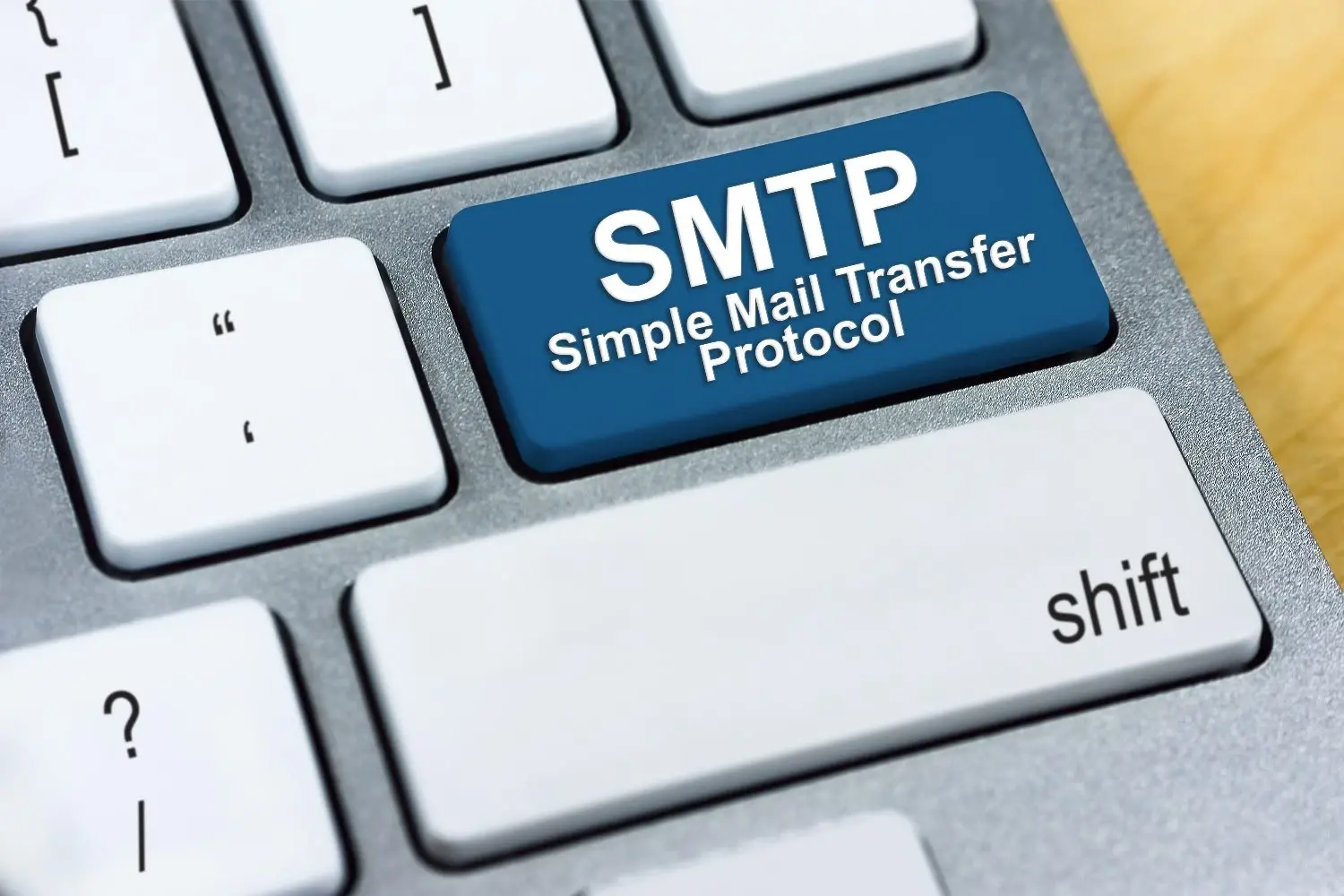In the fast-paced digital world, email communication is essential to our daily lives. We use them to connect with others, whether for personal or business purposes. Behind the scenes of this seemingly simple process lies the critical role of SMTP (Simple Mail Transfer Protocol).
SMTP is the underlying technology that enables the delivery of emails between servers securely and efficiently.
In this article, we will explore Gmail SMTP, a free service provided by Google that makes email communication a breeze.
Benefits of Gmail SMTP
Gmail SMTP is Google's email delivery service that lets you send emails using your domain name, giving a professional touch to your emails.
It is great for individuals and organizations who want a personalized email experience without the hassle of running an entire email server.
Enhanced Email Deliverability
Gmail SMTP has a great reputation for high deliverability rates. Google's powerful infrastructure and vast network of servers ensure that your emails reach recipients' inboxes promptly, avoiding spam folders or delivery delays.
Secure Data Transfer
Security is crucial for email communication. Gmail SMTP uses encryption protocols like TLS or SSL to protect your data while it is sent. This keeps sensitive information safe, like passwords or confidential business data, from potential threats.
Reliable Service
As a service provided by Google, Gmail SMTP offers outstanding reliability and uptime. With a proven track record, you can trust that your emails will be sent and received seamlessly, minimizing the risk of lost messages or communication breakdowns.
Simplified Setup
Setting up Gmail SMTP is easy and requires minimal technical know-how. Once configured, you can start sending emails from your domain name within minutes. Plus, Google's clear documentation and customer support will help you if you face any issues along the way.
Compatibility with Popular Email Clients and Apps
Gmail SMTP works well with many popular email clients and apps, so you can easily use it with your preferred communication platform. Whether you use desktop email clients like Microsoft Outlook or mobile apps on your smartphone, Gmail SMTP fits smoothly into your workflow.
The Role of SMTP in Email Sending

SMTP, Simple Mail Transfer Protocol, is essential for sending, receiving, and relaying emails on the Internet, ensuring secure and efficient delivery.
How SMTP Works
When you hit the "Send" button on your email client or application, SMTP steps into action to facilitate the delivery of your message.
Outbound Mail Server (SMTP Client)
Your email client(Gmail, Outlook, or Thunderbird) acts as the SMTP client. When you compose an email, the client communicates with an outbound mail server, responsible for sending your message. This server is provided by your email service provider or organization.
Sender's SMTP Server (Outbound Mail Server)
The SMTP client connects to the sender's SMTP server (outbound mail server) using a standard port (usually 587 or 465 with encryption). It gives the sender's email address, the recipient's email address, and message content to the outbound mail server.
Sending and Relaying
The sender's SMTP server checks the sender's identity and verifies the recipient's email domain. If everything is good, it tries to send the email to the recipient's server. If the recipient's domain is different, it may relay the email to another SMTP server that can reach the recipient's server.
Receiving Mail Server (SMTP Receiver)
The recipient's mail server acts as the SMTP receiver. When the email arrives at the receiver's server, it performs various checks, such as verifying the sender's identity, checking for spam, and ensuring that the email adheres to any security protocols.
Storing the Email
Once the recipient's mail server accepts the email, it stores it in the recipient's mailbox, awaiting retrieval by the recipient's email client.
Standard SMTP Port Numbers and Their Uses
SMTP uses specific port numbers to facilitate communication between the email client and the SMTP server. The most commonly used SMTP port numbers are:
Port 587 (Submission Port)
This port is designated for email clients to send outgoing emails to the SMTP server. It is used with encryption protocols like TLS (Transport Layer Security) to secure email transmission.
Port 465 (SMTPS)
Port 465 was previously used for SMTP over SSL (SMTPS), an older encryption method. However, it is now deprecated in favour of using Port 587 with TLS for enhanced security.
It is important to note that some email providers or organizations might use different port numbers for SMTP. However, Ports 587 and 465 are the most widely supported and recommended options for secure email transmission.
Key Requirements for Gmail SMTP Setup

To use Gmail SMTP, you need a Gmail account. For added security, use App Passwords or enable Google's 2-step verification. Understanding these requirements will help you use Gmail SMTP confidently and securely for smooth email communication.
Gmail Account
To use Gmail SMTP, you must have an active Gmail account. If you do not have one, you can easily create a free account on the Gmail website.
App Password (Recommended)
For better security, it is highly recommended to generate an App Password instead of your regular Gmail password when configuring SMTP with email clients or apps. This protects your primary Google account from unauthorized access.
App passwords are unique, one-time-use passwords specifically generated for a particular application or device.
Concept of Less Secure Apps and Enabling it for SMTP Usage
Google considers some apps or devices "less secure" because they lack modern security protocols like two-factor authentication or OAuth. To safeguard your account, Google automatically blocks access from these less secure apps to prevent potential security risks.
However, to use Gmail SMTP with certain email clients or applications, you might have to enable access for less secure apps. But be cautious, as it could expose your account to security risks. It is best to use App Passwords or enable Google's 2-step verification instead.
Google's 2-Step Verification Process and Its Role in SMTP Configuration
Google's 2-step verification adds extra security to your account. It requires a second factor like a verification code sent to your phone or generated by an authentication app. Even if someone knows your password, they cannot get in without the second factor.
The 2-step verification process enhances the security of your Gmail account, making it safer against hacks and unauthorized access. It is vital, especially when using SMTP with less secure apps or to generate App Passwords.
Setting Up Google's 2-Step Verification
- Go to your Google Account settings: https://myaccount.google.com/
- Select "Security" from the left-side menu.
- Under "Signing in to Google," click on "2-Step Verification."
- Follow the on-screen instructions to set up the 2-step verification process. You will need to provide and verify a phone number where you can receive verification codes.
After enabling 2-step verification, Google will ask for a verification code when signing in from an unknown device. This includes configuring SMTP settings with less secure apps, where you will need to enter the verification code with your regular Gmail password.
Configuring Gmail SMTP Settings: Step-by-Step Guide
- Log into your Gmail account using this web address https://mail.google.com/.
- Enter your Gmail email address and password in the provided fields.
- Click on the "Sign In" button to access your Gmail account.
- Once you are logged in, click on the gear icon located in the top-right corner of the Gmail interface.
- From the drop-down menu, select "See all settings."
- In the Settings menu, click on the "Accounts and Import" or "Accounts" tab, depending on your Gmail version.
- Scroll down until you find the "Send mail as" section. Here, you will see any aliases or custom email addresses you have set up within your Gmail account.
- Locate the custom email address for which you want to configure the SMTP settings. If you have not added one yet, click on the "Add another email address" link and follow the prompts to add your custom email address.
- Once you have selected or added the custom email address, click on the "Edit info" link next to it.
Configuring SMTP Parameters
- A pop-up will show your custom email details. Check if "smtp.gmail.com" is filled in under the "SMTP Server" section, as it is the Gmail SMTP server address.
- In the "Username" field, your Gmail username (your full Gmail email address) should be automatically populated.
- In the "Password" field, enter your Gmail account password. If you have enabled 2-step verification, and you should if possible for added security, you will need to use an App Password here instead.
- To generate an App Password, follow these steps:
a. Go to your Google Account settings b. Select "Security" from the left-side menu. c. Under "Signing in to Google," click on "App passwords." d. Select "Mail" in the first drop-down menu and "Other" in the second drop-down menu. e. Click "Generate" and follow the on-screen instructions. Take note of the App Password generated, as you will not be able to see it again.
- The "SMTP Port" should be set to "587." This is the standard port for SMTP submission and is used with encryption (TLS) for secure email transmission.
- Check the box next to "Secured connection using TLS (recommended)" to enable encryption for the SMTP connection.
- Click on the "Save Changes" button to save your SMTP settings.
Congratulations! You have successfully configured your Gmail SMTP settings for the selected custom email address. You can now use this address to send emails from your email client or application using Gmail's SMTP server securely and efficiently.
Integrating Gmail SMTP with Popular Platforms

Follow these simple steps to integrate Gmail SMTP with popular platforms like WordPress, Microsoft Outlook, and Mozilla Thunderbird. This allows you to send emails through your Gmail account from these platforms, benefiting from Gmail's reliable SMTP service.
Integrating Gmail SMTP with WordPress
- Log in to your WordPress dashboard.
- Go to "Plugins" > "Add New."
- Search for "WP Mail SMTP" in the plugin search bar.
- Click "Install Now" and then "Activate."
- Navigate to "Settings" > "Email" in your WordPress dashboard.
- Choose "Other SMTP" as the mailer.
- Enter your Gmail SMTP settings: SMTP Host: smtp.gmail.com SMTP Port: 587 Encryption: Use TLS Authentication: ON SMTP Username: Your full Gmail email address SMTP Password: Enter the App Password generated in the previous section (if 2-step verification is enabled).
- Scroll down and enter an email address where you want to receive the test email.
- Click the "Send Email" button to test if your Gmail SMTP integration is successful.
Integrating Gmail SMTP with Microsoft Outlook
- Launch Outlook on your computer.
- Add a New Email Account:
- Click on "File" in the top-left corner.
- Under "Account Information," click "Add Account."
- Select "Manual setup or additional server types" and click "Next."
- Choose "POP or IMAP" and click "Next."
- Fill in the following information: Your Name: Your display name Email Address: Your full Gmail email address Account Type: IMAP Incoming Mail Server: imap.gmail.com Outgoing Mail Server (SMTP): smtp.gmail.com User Name: Your full Gmail email address Password: Enter the App Password generated in the previous section (if 2-step verification is enabled).
- Click on the "Test Account Settings" button to verify your settings and ensure that the connection to Gmail's SMTP server is successful.
- If the test is successful, click "Next" and then "Finish" to complete the setup.
Integrating Gmail SMTP with Thunderbird
- Launch Thunderbird on your computer.
- Click on "Local Folders" in the left-hand sidebar.
- From the menu, select "View settings for this account."
- In the Account Settings dialog box, click "Account Actions" > "Add Mail Account."
- Enter your name, Gmail email address, and password in the provided fields.
- Click "Continue."
- Select "Manual config" when Thunderbird tries to configure the server automatically.
For the Outgoing Server (SMTP), set the following: Server Name: smtp.gmail.com Port: 587 Connection Security: STARTTLS Authentication method: Normal password Username: Your full Gmail email address Password: Enter the App Password generated in the previous section (if 2-step verification is enabled).
- Click on the "Done" button to save your settings.
- Send a test email to verify if your Gmail SMTP integration is successful.
Troubleshooting Common Gmail SMTP Issues
Authentication Errors
Issue: Authentication errors occur when the SMTP client fails to provide the correct credentials (username and password) for the Gmail SMTP server. Solution: Double-check your Gmail username and password to ensure they are correct. If you have enabled 2-step verification, use the App Password generated for your email client. And, ensure that no security software or firewall is blocking the SMTP connection.
Connection Timeouts
Issue: Connection timeouts happen when the SMTP client cannot establish a connection with Gmail's SMTP server within a specific time frame. Solution: Check your internet connection to ensure it is stable. If you are using a firewall or antivirus software, ensure that it is not blocking the outgoing SMTP traffic. Try changing the SMTP port to 465 (with SSL) or 587 (with TLS) to see if it resolves the issue.
Sending Limits Exceeded
Issue: Gmail imposes sending limits to prevent abuse. If you send a large number of emails within a short period, you may encounter sending limits exceeded errors. Solution: Respect Gmail's sending limits to avoid this issue. If you need to send bulk emails, consider using a dedicated email marketing service instead.
Suspicious Activity Detected
Issue: Google may flag your account for suspicious activity if it detects unusual login patterns or if you are sending emails in large volumes. Solution: If you receive a suspicious activity notification, follow Google's instructions to secure your account. Change your password and review recent account activity to ensure no unauthorized access.
SMTP Server Unreachable
Issue: The SMTP server (smtp.gmail.com) may become temporarily unreachable due to server maintenance or network issues. Solution: Wait for a while and try again later. If the problem persists, check the Gmail status page to see if there are any ongoing server issues.
SMTP Error Codes
SMTP error codes are three-digit numbers that indicate the status of the email delivery process. They help identify the specific issue preventing successful email transmission. Here are some common SMTP error codes, meanings and possible solutions:
500 series (e.g., 550, 554): These codes indicate that the recipient's mail server has encountered a permanent error, and the email could not be delivered.
Possible solutions include:
- Double-check the recipient's email address for any typos.
- Contact the recipient to verify if their email server is working correctly.
- Ensure your email content does not violate any spam or security policies.
400 series (e.g., 421, 450): These codes indicate a temporary error on the recipient's mail server, and the email delivery is deferred.
Possible solutions include:
- Try resending the email after a short delay.
- Check if the recipient's mail server is experiencing issues or maintenance.
200 series (e.g., 250): These codes indicate successful email delivery. No action is required as the email has been sent successfully.
550 series (e.g., 550): This code means that the recipient's mailbox is unavailable or does not exist.
Possible solutions include:
- Verify the recipient's email address for accuracy.
- Contact the recipient through an alternative method to confirm the correct email address.
421: This code indicates the recipient's mail server is experiencing an overload or temporary issue.
Possible solutions include:
Wait for a while and try sending the email again later.
553: This code indicates that your email server is not authorized to send emails to the recipient's domain.
Possible solutions include:
- Check if you have the proper permissions or credentials to send emails to the domain in question.
- Consider using an authenticated SMTP connection to ensure authorization.
When using Gmail SMTP, be aware of potential issues and how to troubleshoot them. Follow the suggested solutions and understand SMTP error codes for smooth email communication. If problems persist, contact Google Support for expert help.
Gmail SMTP Limitations
Daily Email Sending Limit
One of the primary limitations of using Gmail's free SMTP service is the daily email sending limit. For regular Gmail accounts, the daily email-sending limit is 500 emails. This limit can be restrictive for businesses or individuals who need to send a large volume of emails daily.
Limited Customization and Branding
Gmail SMTP has limited customization and branding options. Your emails may not look as professional as those sent from a custom domain or a business email service.
Dependency on Google Infrastructure
With Gmail SMTP, you depend on Google's infrastructure and servers for your email communication. Though Google offers a reliable service, there may be occasional disruptions or outages that affect email delivery.
Ways to Overcome Gmail SMTP Limitations
Upgrade to Google Workspace (Formerly G Suite):
To overcome Gmail's free SMTP limitations, upgrade to Google Workspace. It offers more features, higher email-sending limits, and better customization options. With Google Workspace, you can use your own domain name for email addresses, making your emails look more professional.
Use Third-Party Email Service Providers:
If you require higher email-sending limits or more advanced features, consider using third-party email service providers. These services specialize in email marketing and transactional emails and offer scalable plans to meet your needs.
Optimize Email Communication:
To stay within Gmail's free SMTP limits, optimize your email communication by segmenting your recipients and sending relevant and targeted messages. Avoid unnecessary mass emails, and ensure that your email lists are up-to-date to minimize email bounces.
Combine with Other SMTP Services:
You can use Gmail SMTP for regular email communication and rely on other SMTP services for specific use cases, such as email marketing campaigns. This way, you can get the best of both worlds to meet your needs.
Conclusion
Reliable email delivery is crucial in today's digital world. Gmail SMTP offers enhanced deliverability, secure data transfer, and easy setup, making it perfect for individuals and businesses. It fosters strong connections with clients, partners, and colleagues.
Although Gmail's free SMTP is good for regular emails, it has limitations. Upgrade to Google Workspace for a better solution. Also, try third-party providers and optimize email communication for improved Gmail SMTP delivery.
Do you have any questions or thoughts on this topic? Share in the comments!
Frequently Asked Questions
Are there alternatives to Gmail SMTP?
Yes, there are third-party email service providers like Microsoft Outlook/Office 365 SMTP, Amazon SES, SendGrid, Mailgun, SparkPost, and Mandrill. They offer scalable plans for email marketing and transactional emails, catering to different needs beyond Gmail SMTP's limitations.
Can I use Gmail SMTP for bulk email campaigns?
While Gmail SMTP is suitable for regular email communication, but not ideal for bulk email campaigns due to its sending limits. For bulk email campaigns, use specialized email marketing services or third-party SMTP providers designed for handling large volumes of emails.
Why should I use Gmail SMTP instead of my hosting server's SMTP?
Using Gmail SMTP offers benefits such as enhanced deliverability, reliable service, secure data transmission, and compatibility with popular platforms. It allows you to send emails with your personalized domain name, giving a professional touch to your communication.
Is there a daily limit for sending emails through Gmail SMTP?
Yes, Gmail SMTP has a daily limit for sending emails. For regular Gmail accounts, it is 500 recipients per day. G Suite (Google Workspace) accounts have varying limits, like 2,000 recipients for free trial users and 2,000 to 2,500 recipients for paying users per day.
What is 'Less Secure App Access,' and why is it related to Gmail SMTP?
'Less Secure App Access' is a setting in Google accounts that decides if certain apps or devices with lower security can access your Gmail account. It affects Gmail SMTP because some apps may be "less secure," so you need to enable this setting to use Gmail SMTP with them. But for better security, it is advised to use App Passwords or enable 2-step verification.

Yetunde Salami is a seasoned technical writer with expertise in the hosting industry. With 8 years of experience in the field, she has a deep understanding of complex technical concepts and the ability to communicate them clearly and concisely to a wide range of audiences. At Verpex Hosting, she is responsible for writing blog posts, knowledgebase articles, and other resources that help customers understand and use the company's products and services. When she is not writing, Yetunde is an avid reader of romance novels and enjoys fine dining.
View all posts by Yetunde Salami



















